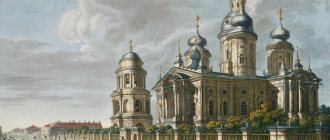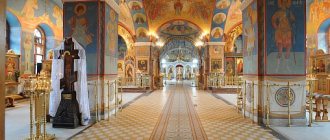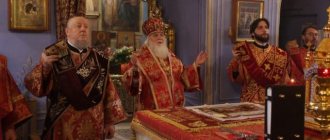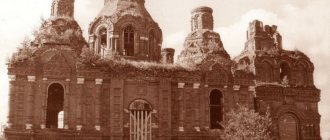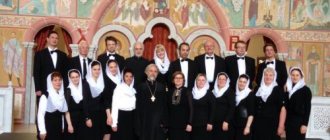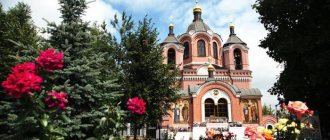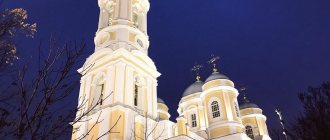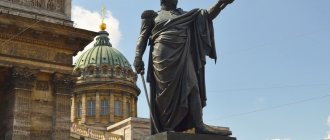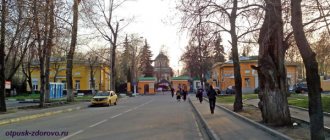| Prince Vladimir Church at the Diocesan House. Photo from the site sobory.ru |
House church in honor of the Holy Equal-to-the-Apostles Prince Vladimir at the Diocesan House of the City of Moscow,
Moskvoretsky Deanery of the Moscow City Diocese
- Thrones: Equal. book Vladimir (upper), St. Tikhon of Moscow and the Holy Fathers of the Local Council 1917-1918 (lower)
- Address: Russia, Moscow, Likhovy per. d. 6, p. 1.
- On the map: Yandex.Map, Google map
The foundation stone of the house church took place on June 14, 1901 at the Diocesan House.
It was located on the second floor of the extension, adjacent to the large hall in the center of the house and could be separated from it by an iron curtain. Project by architect P.A. Vinogradova. Painted by artist V.P. Guryanov. It was consecrated on December 30, 1902 by Metropolitan of Moscow Vladimir (Epiphany). The Governor General of Moscow, Grand Duke Sergei Alexandrovich, and his wife, Grand Duchess Elizaveta Feodorovna, were present at the celebrations. Daily services were held in the temple. Sunday and holiday liturgies were sung by a choir of Moscow factory workers under the direction of S.A. Solntseva and the choir of the Society of Lovers of Church Singing. On Sundays, Vespers was celebrated with general folk singing, after which conversations of religious and moral content were held.
| House Prince Vladimir Church before the revolution. Photo from the website of the Russian Orthodox Church |
The temple was connected to the cathedral chamber, in which on September 28, 1917, a decision was made to restore the patriarchate in the Russian Orthodox Church.
After the revolution, the temple was finally closed on June 15, 1922. The building of the diocesan house was completely redone, the church annex was disfigured, but was preserved.
Returned to the Church in 2004 and transferred for the needs of the Orthodox St. Tikhon's Humanitarian University.
In 2006, reconstruction of the building of the diocesan house and the Vladimir Church began, which was completed in the summer of 2015.
On July 26, 2015, Patriarch Kirill performed the rite of great consecration of the upper house church of Equal-to-the-Apostles Prince Vladimir in the Moscow Diocesan House and the Divine Liturgy in the newly consecrated church. The lower church was also consecrated in the name of St. Tikhon and the fathers of the All-Russian Local Council of the Russian Orthodox Church of 1917-1918, glorified as saints [1].
The temple is assigned to the parish of the Church of St. Nicholas of Myra in Kuznetsy.
History of the Vladimir Church
About the Orthodox schoolHistory of the Church of St. Prince Vladimir
- History of the school
- History of the Ivanovo Monastery
- History of the Church of St. Prince Vladimir
The temple is dedicated to the one who baptized the Russian land, who gave us Christianity. The Holy Equal-to-the-Apostles Grand Duke Vladimir was the younger brother of the Grand Duke Svyatoslav and the grandson of the Holy Equal-to-the-Apostles Olga. At the beginning of his reign, he was a zealous idolater, but then, like his great grandmother, he saw the errors of paganism and began to seek the truth. After a long search, the Grand Duke decided to convert to Orthodoxy. The chronicle says that he was 25 years old when he was baptized, and in 988 a great national event took place - the Baptism of Rus'. Prince Vladimir himself, having accepted the Orthodox faith, was transformed and became a different person. In paganism he was cruel and voluptuous, but after baptism he became a humane ruler and was even afraid of shedding the blood of villains and enemies. Together with St. With Vladimir, all of Rus' changed: from a barbarian country it turned into Holy Rus', and a whole host of holy saints of God shone in it.
The Church of St. Prince Vladimir in Starye Sadekh has existed for almost four centuries. It is first mentioned in the spiritual charter of Grand Duke Vasily Dmitrievich, written in 1423, which speaks of the “New Court” outside the city near St. Vladimir, which the prince bequeaths to his son along with the patrimony - the “Grand Duchy.” The temple at that time, in all likelihood, was wooden.
In 1514, the famous architect from Milan Aleviz Fryazin arrived in Moscow. By order of Grand Duke Vasily Ivanovich, he began the construction of eleven stone churches, including ours, the only one in Moscow consecrated in honor of the Baptist of Rus'.
The name Old Gardens appeared at the end of the 15th century, when, under Grand Duke Ivan III, the country grand-ducal palace was moved to Vorontsovo Field. It preserves the memory of the old gardens that once adorned this corner of Moscow and in which rare fruits were grown for the grand ducal table.
In the second half of the 17th century, the old building was dismantled. The current temple was built in 1660. South aisle in the name of St. Kirik and Iulita were first mentioned in the “ruzhny book” in 1677. Consecration of the chapel of Sts. Boris and Gleb took place in 1689, and Princess Sofya Alekseevna was present. The bell tower was also rebuilt on the old foundation. Based on the characteristic architectural techniques, it is not difficult to determine that the temple belongs to the 17th century. Porch with supports-pods, finishing of the walls with kokoshniks, lancet windows with platbands made of hewn brick. The design of the chapters in the form of a relief ornament is very beautiful. The bell tower adjacent to the temple was rebuilt after a fire in the 18th century, as can be seen from the final spire. The books of the state Patriarchal Order reveal precious details of the life of the parish, the names and years of service of the priests, the amount of their salaries, even the amount of incense issued.
From the archives we learn that the church had two chapels. On October 20, 1737, the widow of the steward Fyodor Petrovich Verderevsky, Tatyana Fedorovna, was given a decree: “In the chapel of the Blessed Princes Boris and Gleb, re-build a roof and remove icons and other church splendor inside. As soon as this chapel is erected, strike with your forehead for consecration.” It took place on January 28, 1738.
The parishioners considered it not a duty, but an honor to take care of their temple. So in 1787, when the crosses shook during a strong storm, they “asked permission to gild them, fix the heads on this church and cover them with sheet iron.” Not without their participation, until 1711, the patriarchal almshouse was maintained, where from “41 to 788 people, male and female,” were warmed. With the destruction of the patriarchal throne in Moscow, the almshouse was also closed. Currently, a two-story stone clergy house stands in its place. Based on the protocols stored in the archives of the Moscow Theological Consistory, one can judge the rich decoration of the temple. On May 24, 1751, it was recorded that in the presence of priest Alexey Grigorievna, a crown and silver hryvnias with enamel, strung with pearls and yahonts, were stolen from the image of the Savior.”
Until 1812, there was a large cemetery near the temple. Today, on the church grounds there is a cross, under which lie the remains discovered during restoration work in our time.
When Moscow burned in 1812, the Vladimir Church also suffered. At this time, she “had eleven households, 220 male residents, 240 female residents.” After the fire, the church was assigned to the Church of St. Kosma and Damian, on Pokrovka, and the surviving property was transferred to the Church of St. John the Baptist in St. John's Monastery.
Two years after the fire, a request was received from the actual state councilor Mikhail Volynsky for permission to repair the Prince Vladimir Church.
On January 26, 1814, the Decree of the SA took place. Synod on the restoration of the temple.
In 1818, in the presence of Fr. The dean of St. John the Baptist Church accepted the utensils and various church items. Money belonging to the Church of St. book Vladimir was not there. The main church was consecrated on October 19, 1819 by His Eminence Metropolitan Seraphim of Moscow and Kolomna, and on November 9 of the same year by His Eminence Lawrence, Bishop of Dmitrov, Vicar of Moscow, the border was also consecrated in the name of St. Blessed Princes Boris and Gleb. In 1819, there were 10 households in the church parish, 124 males and 123 females.
Another chapel in the name of the holy martyrs Kirik and Julitta was consecrated only on January 16, 1827 by Metropolitan Philaret of Moscow and Kolomna.
Until 1780, the staff of the clergy of the Vladimir Church consisted of a priest, a deacon and one psalm-reader. The maintenance of this church and the clergy's service was first neglected, and then stopped for an unknown reason, and the clergy no longer received any benefits from the treasury and was supported by services in the church, correcting needs in houses and leaving houses belonging to the church. Moreover, the church and clergy received for their maintenance a percentage of the capital laid down by the testators for perpetuity. The clergy lived in church houses, of which one stood in the churchyard, and the other on the corner of Khokhlovsky and Ivanovsky lanes.
Opposite the Church of St. Vladimir is the ancient Ivanovo monastery. In the old days, on the day of the temple holiday - the memory of the Beheading of the Prophet, Forerunner and Baptist of Christ John on August 29 according to the old style (September 11 according to the new style) near the church of St. A wool fair took place in Prince Vladimir. A mass of peasant carts with wool were located near the temple and the Ivanovo Monastery, crowds of pilgrims came to this holiday, blocking the entire passage. Church of St. book Vladimir’s house was not locked from morning to evening, because all the visiting merchants - peasants - used the proceeds from the sale of wool to serve prayers to the Baptist of Christ. Prayer services were served in the most abbreviated form, 2-3 minutes each. During the two days of the holiday, the priest had to serve more than 800 prayer services.
From the memoirs of F.A. Gilyarov, the son of priest Alexander Petrovich Gilyarov, who served in the Church of St. n. Vladimir in the second half of the 19th century, we learn that on this day the image of the truncated head of John the Baptist lay on the lectern. The head was decorated with a corolla with a bunch of red threads threaded through it. After the prayer service, pilgrims venerated the image and took a red thread as a souvenir.
Almost five centuries to the temple of St. Book Vladimir. Like all of Moscow and Russia, the church, clergy, and parishioners had to endure a lot of hardships, troubles and misfortunes during this time: Tatar raids, Polish intervention, plague and French invasion, revolution and persecution of the church in the 20th century. Among the Russian new martyrs and confessors of our time is the penultimate rector of the church, Fr. Vladimir Ambartsumov, executed on November 5, 1937 at the Butovo training ground.
In the 1930s the church was closed. They broke all the chapters and destroyed the interior decoration. On January 28, 1933, the Presidium of the Moscow City Council considered the petition to close the church of “the so-called Vladimir” and decided: “taking into account: 1) the urgent need for premises for the OGPU and 2) the suitability of the premises of the so-called church for this purpose. Vladimir,” close it and transfer it to the OGPU.”
Later, the temple housed the storage of books of the Historical Library. From the second half of the seventies, slow restoration began in the temple. By 1979, the bell tower was restored and a cross was erected on it. By 1990, the restoration was completed. At the end of 1990, the temple was transferred to the St. Vladimir Charitable Brotherhood, Fr. Sergiy Romanov. Following their confessor, the already formed community moved from Vinogradov to the center of Moscow. The first service and consecration of the Church of St. book Vladimir took place on May 24, 1991, on the day of remembrance of Saints Equal-to-the-Apostles Cyril and Methodius, teachers of Slovenia.
What to see near the temple
Near the temple there are many attractions of the historical and architectural complex. After visiting the cathedral, you can go to the Hologram Museum, where holographic images of valuable historical monuments are presented. Nearby is an exhibition of ancient amphorae. Archaeological finds are placed under glass directly in the open air. Next you can see the ancient Korsun Church, built at the end of the 19th century.
Art lovers will be interested in visiting the “Green Pyramid” gallery - this building was built according to an individual project in the style of an ancient Greek estate. The gallery is in perfect harmony with the natural landscape and ancient architectural environment. It regularly hosts exhibitions of various art styles and thematic festivals. Creative meetings and musical evenings also take place here.
Walking around the complex, you can see the remains of ancient city buildings. Of particular interest are the amphitheater, the ruins of an ancient temple, and the remains of towers.
Those wishing to learn more about the history of Chersonesus should visit the local museum. It contains many ancient exhibits that were found during excavations of the ancient city.
Remains of the ancient city, © Maria Chakhnashvili
How to get there
To get to the temple, you need to get to the “Khersones Tauride” stop by bus No. 22, which runs every 20 minutes. From the stopping point you should move to the main entrance of the historical and architectural complex. Upon entering its territory, you need to go straight along the main alley.
Transport stops near St. Vladimir's Cathedral
It is more convenient to get to the temple by taxi. To do this, you can use the application of one of the following companies: Yandex. Taxi, Maxim, "Lucky".
Preparation of St. Vladimir's Cathedral in Chersonesus for Easter: video
Schedule of services in Vladimir Cathedral
Every year, commemorative services are held in the Admirals’ Tomb to mark significant events for the Russian fleet. On May 13, a prayer service is held here in honor of the Black Sea Fleet, and memorial services are held for the sailors who died during the first and second defenses of Sevastopol. Modern tragic events in the history of the fleet are also reflected in the schedule of services of the Vladimir Cathedral. Every year a memorial service is held here for the sailors who died on the Kursk submarine.
Divine services are also held on a weekly basis. You can visit them on Mondays, Fridays, Saturdays and Sundays.
Schedule of services in Vladimir Cathedral
© SvetlanaIR
